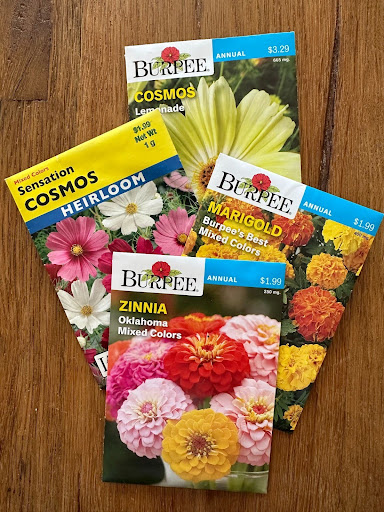
Starting seeds indoors is a fun winter activity and allows you to grow plants not commonly found in garden centers.
Here are our six tips for success with indoor seed starting.
Timing
A common mistake when seed starting is to start the seeds indoors too early. This often leads to overgrown plants which perform poorly when moved outdoors. he average last frost free date in the Minneapolis area is about May 10. Keep this date in mind as this is generally when warm season plants such as peppers, tomatoes, eggplants and most annual flowers can be planted outdoors.
Cool season plants such as spinach, cabbage, broccoli and pansies can tolerate cooler temps and can be planted before May 10. Knowing that information, look at the back of the seed packet which will tell you how many weeks in advance you should sow your seeds. The back of the packet will also often give you additional information such as how far apart to space your plants outdoors, how long the seeds take to germinate, etc.
Use a seed starting soil mix
Always use a good quality seed starting mix and not potting or garden soil when starting seeds. Seed starting mixes are lighter which aids in root growth and helps provide a disease free growing media. Make sure your seed starting containers are clean/sterilized to help prevent disease problems. Previously used containers should be thoroughly cleaned and then soaked in a one part bleach to nine parts water solution followed by an additional rinse.
Heat mats
Are seed starting heating mats necessary? No. Do they aid in germination for many types of seeds? Yes. Warm season crops germinate best at temps of 80 degrees, which is warmer than our house temps. Setting your seeded trays/containers on a heat mat will increase your seed germination.
Grow lights
Your indoor seed starting success will be far greater when plants are grown under grow lights versus a south facing, unobstructed window. Grow lights should be on for 16 hours and off for 8 hours per day. How close the lights should be placed to the seedlings will vary on the type of light you are using. If the plants are stretching to the light, lower your lights slightly.
Watering
A common mistake with all plants growing indoors is too much water. Check your seedlings before watering to make sure the soil surface is dry to the touch. Water from the bottom, meaning that containers or trays are set in water and allowed to soak up water which will prevent the seed starting mix from becoming compacted. Once the soil is soaked remove the seed trays from the water and allow the soil to drain.
When your seedlings have established the first true leaves, they can be fertilized with a very diluted water soluble fertilizer.
Hardening off
The plants that you’ve started indoors need to gradually get used to outdoor conditions before planting even if they have been growing under lights. The process of acclimating them to outdoor conditions is called hardening off which can take 7-10 days. Start by placing your seedlings outdoors in a protected location and give them a few hours of early morning light. Slowly increase the amount of light they get each day. This process prevents the seedlings from getting sunburned.
We are here to help
If you have any questions or want to call in a local garden expert, get in touch with Pleasant View Gardens and we will be happy to help!
Pleasant View Gardens
Long Lake, MN 55356
